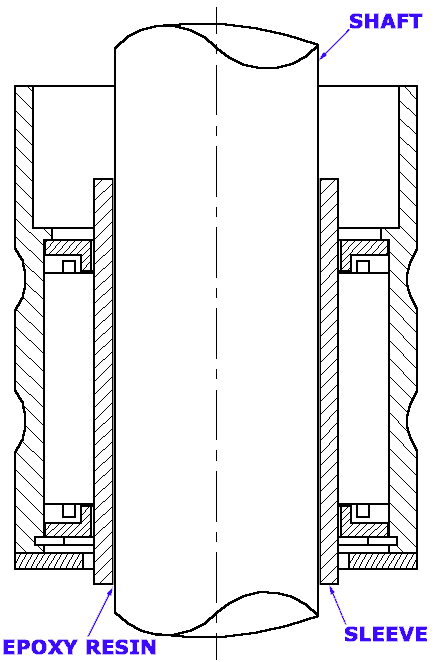Converting from plain bearings to roller bearings
Many boat owners around the world complain about backlash and movement in their rudder system. Under motor these rudder systems start rattling and oscillating due to the propeller wash. The feel of the helmsman on his rudder is the most important contact to the sailing yacht. If every steering correction has to overcome a certain backlash, it’s very irritating and even could be dangerous in conditions were precise steering is crucial. A conversion to Jefa roller bearings will provide these helmsmen a backlash free and light rotating solution.
Another reason for converting to roller bearings is a blocking or badly rotating rudder under load. As the friction coefficient of a plain bearing is much higher than the friction coefficient of a roller bearing, the rudder could lock under heavy load.
It’s not possible to just remove the old plain bearing, and slide a Jefa roller bearing over the shaft. The Jefa roller bearing requires a high tolerance finished shaft piece for it to run on. (Please have a look in the photo gallery of a bearing conversion at the bottom of this page) The existing rudder shaft will not have this high tolerance. It’s also expectable that the shaft will be damaged by the gliding bearing, creating a non uniform surface. This damage will be relatively small if the rudder shaft is made of stainless steel. But when the rudder shaft is made of aluminium, the loss of material could be tenth of millimetres. The reason for this is the fact that the protection against corrosion of aluminium isn’t achieved by the material itself (like stainless steel) but by the very thin oxide layer at the surface of the material. This oxide layer will prevent any further oxidation of the aluminium. But the strength of this oxide is far from the original strength of the aluminium. The consequence is that on every shaft rotation a bit of this oxide layer will be torn of the surface and new fresh aluminium will oxidise again to protect the shaft. This principle shows that it’s very unwise to use gliding bearings on aluminium rudder shafts. When roller bearings are used, these problems will never occur. The rollers will roll over the shaft surface, leaving it untouched. Even on the highest possible loads, the surface oxide layer will never be removed from the shaft.
The only way to get a correct high tolerance surface on the shaft is to put a sleeve over the original shaft. To specify this sleeve one should carefully measure the shaft to the tenth of a millimetre for the biggest diameter. Don’t measure the damaged part of the shaft as the diameter will be smaller than just above or beneath the damaged area and one will not be able to slide the sleeve over the shaft. Also be aware that the shaft doesn’t necessarily have to be round. It could be oval. Please measure the biggest diameter of the oval. Jefa marine will produce the inside of the sleeve 0.25 mm bigger than the biggest diameter measured. The wall thickness will be around 3 mm (dependant of the final outside diameter that has to be reached).
As there will be no vertical loading on the sleeve, the sleeve can be glued to the shaft. Before you put glue on the shaft, first dry run the sleeve over the shaft, making sure it fits. As the room between the shaft and the sleeve is only a couple of tenths of a millimetre one should use a thin epoxy resin (for example Araldit, available in every marine shop). Clean the shaft and inside of the sleeve. Put the epoxy resin around the shaft and inside of the sleeve and slide the sleeve over the shaft while rotating. Remove all obsolete resin with a cloth and a dissolvent. Seal the top and bottom with sicaflex so no water can run between the shaft and sleeve.
The rest of the installation procedure is exactly the same a on a new yacht. Please read our installation section for further details.
Please do not expect you can put a Jefa roller bearing in the existing rudder tube of your boat. The inside diameter of this tube is made to suit a thin gliding bush. In most cases the outside diameter of the Jefa bearing will be much bigger than the inside diameter of the existing tube. The best is to break out the existing tube and start from scratch.
Example: Photo gallery of the bearing conversion on a Dehler 31
